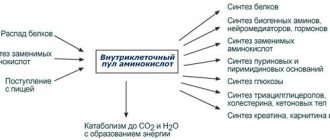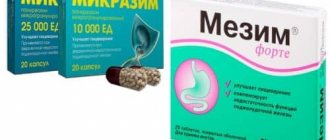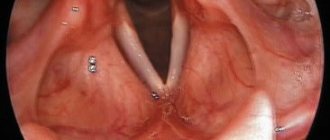Causes of malabsorption
More than 150 diseases associated with malabsorption are known1. These may be congenital malabsorption disorders (primary), or disorders that occur against the background of diseases of the small intestine and internal organs (secondary)4.
Digestion and absorption of nutrients in the intestine occurs as a result of a complex interaction between its motor, excretory, digestive and absorption functions. Various factors can disrupt these processes and affect absorption2.
The most common causes of malabsorption include:
- Celiac disease associated with a genetic feature - intolerance to gluten (the protein of some grains)4. When gluten products are consumed, autoimmune inflammation begins in the intestines1.
- Pancreatic enzyme deficiency. Inflammation of the pancreas (chronic pancreatitis) or surgery on it can lead to insufficient secretion of enzymes necessary for the digestion of proteins, fats and carbohydrates2,8. In severe forms, when less than 10% of gland cells perform their function, symptoms of malabsorption appear3.
- Bile deficiency. Normally, bile acids - components of bile - are involved in the digestion of fats to ensure their absorption from the intestine2. In diseases of the liver and gall bladder, there is a lack of bile in the intestinal lumen, which can interfere with the absorption of fats and fat-soluble vitamins3 (A, D, E, K)14.
- Chronic gastritis. In some forms of gastritis, the acidity of the stomach is significantly reduced. Under such conditions, its mucous membrane does not absorb iron and sometimes vitamin B12 well. Their deficiency contributes to the development of anemia3.
- Inflammation of the intestines (Crohn's disease). Inflammation of the intestinal wall can impair nutrient absorption6. Crohn's disease affects different parts of the intestine where certain substances are absorbed. Therefore, sometimes there is a deficiency of one or more food components, such as vitamin B12, calcium, magnesium or protein3.
- Bacterial overgrowth syndrome (SIBO) is the result of a disruption of the normal established “microbial ecology” of the small intestine5. In SIBO, it contains bacteria that normally live in the large intestine. Once in the upper gastrointestinal tract, these bacteria consume some of the macro- and microelements and contribute to the development of malabsorption. In addition, bacterial enzymes disrupt the exchange of bile acids and, consequently, the absorption of fats2.
The listed diseases can lead to problems with the skin, because it, like other organs, lacks nutrients due to malabsorption3. The skin is especially sensitive to a lack of iron1, zinc, essential fatty acids8, fat-soluble3 (A, K, E, D14) and water-soluble vitamins8 (B, C, PP)14.
to come back to the beginning
Etiology and pathogenesis
The direct cause of the disorder in the absorption of food ingredients may be the reduced activity of digestion enzymes and transport carriers of the final products of digestion through the intestinal wall. Another reason for M. s. is an insufficient supply of enzymes to the intestines with digestive juices due to blockage of the ducts of the glands of the mucous membrane of the small intestine with a viscous secretion, as is observed, for example, in cystic fibrosis. What matters is the lack of formation of enzymes that break down, for example, proteins, which leads to a deficiency of amino acids and protein starvation of the body.
Inactivation of cleavage enzymes and transport carriers also causes the development of M. s. Thus, some antibiotics (chlortetracycline, neomycin) can suppress lipid breakdown processes and increase steatorrhea (see).
When there is an excess of calcium and magnesium salts in food, fat absorption is impaired. In the emergence of M. s. Morphological changes in the small intestine and impaired peristalsis of the gastrointestinal tract are important. tract.
Pathogenetic mechanisms of M. s. diverse. With a deficiency of pancreatic enzymes, the cavity, or pancreatic, phase of digestion suffers; with a deficiency of intestinal enzymes (disaccharidases, peptidases, etc.), the surface, or membrane, phase of digestion is disrupted (see). Intestinal dysbiosis causes changes in the structure of bile cells, hepatobiliary diseases change their metabolism and are accompanied by cholestasis - all this contributes to the disruption of hydrolysis and transport of lipids (biliary phase). In various diseases and lesions of the small intestine, especially in the case of mucosal atrophy, the structures responsible for absorption processes (Cellular phase) are affected to varying degrees. In this case, the absorption epithelium transforms into glandular epithelium, and the diameter of the burrows on the surface of the mucous membrane through which absorption occurs decreases. A number of biochemical defects may occur: the number of transport carriers decreases, their structure changes, as a result of which their ability to interact with transported substances decreases; energy processes that ensure membrane transport are disrupted, etc. As a result of changes in the endocrine functions of the cells of the intestinal wall, the hormonal regulation of digestive and transport processes suffers. In case of disturbances in intestinal lymph flow and mesenteric circulation, further transport of absorbed substances (outflow phase) worsens. When the passage of food masses through the small intestine accelerates, due to motor disorders, the time of contact of chyme with the absorptive surface of the intestine is reduced.
Symptoms of malabsorption
The “poor absorption” syndrome is almost always manifested by diarrhea3,4 - liquid or semi-liquid stool, which is excreted more than 3 times a day13. One of the features of the syndrome is steatorrhea, in which stool has an “oily” appearance and is difficult to wash off4.
Typically, malabsorption syndrome is suspected when weight loss occurs due to diarrhea14. But it is worth paying attention to its other signs that arise due to a deficiency of proteins, fats, carbohydrates, microelements and vitamins4, for example, symptoms of malnutrition of the skin, nails and hair12:
- dryness and roughness of the skin4;
- the appearance of cracks, redness4 and pigmentation14 on the skin;
- skin rash4;
- brittleness4 and slow growth of nails1;
- transverse grooves on nails1;
- thinning, thinning and dry hair1;
- baldness1.
to come back to the beginning
Clinical picture
One of the most important wedge, symptoms of M. s. in children it is chronic, diarrhea, and a unique indicator of insufficient absorption is steatorrhea - increased excretion of lipids in feces. The child stops gaining weight, malnutrition develops, and then exhaustion, and growth retardation (hypostature) is observed. Depending on the duration and nature of the process, changes in other organs and systems increase: the skin becomes dry, with a pellagroid coloration; glossitis is pronounced, the tongue is red without papillae; swelling appears due to disturbances in protein and water-electrolyte metabolism; hypochromic anemia, hypokalemia, hyponatremia, hypocalcemia are noted. In some forms of M. s. changes in the urine are observed, for example, with milk intolerance associated with lactose deficiency; in some cases, lactosuria is noted in the urine (see). There may be seizures, osteoporosis or osteomalacia due to calcium deficiency in the body; bloating, intestinal colic due to hypokalemia and increased fermentation processes in the intestines. However, M. s. can proceed without any sharp disturbances from the gastrointestinal tract. tract.
In adults, wedge, picture of M. s. largely due to the nature of the underlying disease. The intensity of intestinal symptoms (stool upset, rumbling, etc.) depends on the degree of intestinal damage, on the involvement of the colon in the patol process, often there are no intestinal symptoms at all. General manifestations predominate, indicating violations of the basic metabolic processes and functions of a number of organs and systems, which is associated with insufficient supply of nutrients to organs and tissues.
Patients complain of increased fatigue, decreased performance, weakness, decreased appetite, weight loss, sometimes exhaustion up to cachexia (see). They experience dry skin, hair loss, and increased brittleness of nails. There may be diarrhea, steatorrhea, creatorrhea. In the blood - hypoproteinemia, dysproteinemia, changes in the composition of blood amino acids, in the urine - hyperaminoaciduria (see Aminoaciduria). The concentration of cholesterol, total lipids and their fractions in the blood serum decreases. Wedges and signs of thiamine deficiency (paresthesia in the limbs, pain in the legs, sleep disorders), riboflavin (cheilitis, angular stomatitis), nicotinic acid (glossitis, pellagroid skin changes), ascorbic acid (bleeding gums) and others are often observed vitamins (see Vitamin deficiency). A number of wedges, symptoms are caused by impaired electrolyte metabolism: hyponatremia (arterial hypotension, tachycardia, dry skin and tongue, thirst), hypokalemia (muscle weakness, muscle pain, weakened tendon reflexes, decreased intestinal motility, extrasystole, etc.), hypocalcemia (numbness of lips and fingers, increased neuromuscular excitability, osteoporosis), manganese deficiency (decreased sexual function). In severe cases, osteomalacia with bone fractures and tetany may occur. Iron deficiency and B12-folate deficiency anemia often occur. In the oral cavity there are atrophic processes, desquamative changes in the tongue, and sometimes periodontopathy. The skin becomes atrophic, dry, folded, acquires a dirty gray color, and pigmentation appears. Cracks appear around the mouth, eyes, and anus; in severe cases, the disease is complicated by eczema and neurodermatitis. Changes in the endocrine system are noted (hypocortisolism, sexual function disorders, etc.); in severe cases, pluriglandular insufficiency syndrome may develop with damage to the pituitary gland, adrenal glands, gonads, and thyroid gland (see Polyglandular insufficiency). Neurotic disorders and hypochondriacal conditions are often observed.
Klin, painting by M. s. to a certain extent depends on the localization patol. process in the small intestine. For example, when its proximal parts are predominantly affected, the absorption of calcium, iron, folic acid, and B vitamins is affected. When the middle parts are affected, the absorption of fatty acids and amino acids is impaired. Absorption of monosaccharides is impaired when the proximal and middle parts of the intestine are affected. When the distal parts of the small intestine are affected, there is insufficient absorption of vitamin B12 and bile cells, therefore, in the case of resection of the ileum, in some forms of Crohn's disease, the enterohepatic circulation of bile cells is disrupted.
With M., especially when the distal ileum is affected, the excretion of oxalates in the urine often increases - enteral oxaluria, which can lead to the formation of oxalate stones.
Treatment of malabsorption
To solve skin problems with malabsorption, it is important to replenish the nutritional deficiency, and for this, first of all, you need to eliminate the cause of the disorder. It is also necessary to restore bowel regularity, since diarrhea affects a person’s quality of life9.
If the doctor has determined which product is not absorbed or provokes malabsorption, it should be excluded from the diet9. If you have malabsorption, it is better to avoid foods that can aggravate the lack of substances necessary for the body and cause diarrhea9. Doctors recommend9:
- Drink no more than 1 serving of caffeinated drinks per day;
- limit sugar-sweetened drinks and fruit juices;
- Avoid candy and chewing gum containing sorbitol.
In many cases, treatment of the underlying disease and dietary modification are sufficient to combat diarrhea due to malabsorption, however, when these measures are not enough, loperamide-based antidiarrheals9, for example, Imodium® Express, can be used.10 The drug reduces intestinal motility, thereby increasing transit time (promotion) of its content. Loperamide promotes fecal retention and reduces the urge to defecate by increasing the tone of the anal sphincter10.
Imodium® Express is available in the form of lozenges that dissolve on the tongue in a few seconds and do not require drinking water10.
Imodium® Express is contraindicated for use in children under 6 years of age, in the 1st trimester of pregnancy (use in the 2nd and 3rd trimesters is possible strictly as prescribed by a doctor) and for the entire period of breastfeeding10. Imodium® Express should not be used if there is blood in the stool, with colitis, or in cases where slowing down peristalsis is undesirable due to the possible risk of developing serious complications10. Drugs to combat diarrhea should only be used after consultation with a doctor, as it is important determine its cause, and not just eliminate unpleasant symptoms5.
Often, skin problems for which a person turns to a dermatologist or cosmetologist turn out to be a manifestation of impaired functioning of internal organs4, for example, malabsorption. Treatment of intestinal “poor absorption” is aimed at eliminating its cause, eliminating precipitating factors and relieving common symptoms such as diarrhea5. In most cases, malabsorption syndrome is not a life-threatening condition, but serious complications can occur due to incorrect or delayed diagnosis5. Therefore, consultation with a specialist and treatment under his supervision is necessary.
The information in this article is for reference only and does not replace professional advice from a doctor. To make a diagnosis and prescribe treatment, consult a qualified specialist.
to come back to the beginning
Classification
There are several classifications of M. s. The following classification testifies to the multiplicity of etiological and pathogenetic factors underlying the occurrence of MS. 1. Primary M. s. (hereditarily determined): intolerance to disaccharides (lactose, sucrose, isomaltose, trehalose) - disaccharidase deficiency; peptidase deficiency (celiac disease); enterokinase deficiency; intolerance to monosaccharides (glucose, galactose, fructose); impaired absorption of amino acids (Hartnup disease, Cystinuria, tryptophan malabsorption, methionine malabsorption); impaired absorption of vitamins - cyanocobalamin (B12), folic acid. 2. Secondary M. s. (acquired): gastrogenic, observed after gastrectomy, with gastritis, stomach cancer; pancreatogenic, caused by various diseases of the pancreas (pancreatitis, cystic fibrosis, cancer, tumors of the islet apparatus, etc.); hepatogenic, observed in acute and chronic liver diseases, intra- and extrahepatic cholestasis; enterogenous, caused by various intestinal diseases (enterocolitis, celiac disease, Crohn's disease, diverticulitis, blind loop syndrome, infectious, parasitic, vascular intestinal diseases), as well as postoperative (resection of the small intestine); endocrine, observed in diabetes mellitus, hyper- and hypothyroidism; so-called Iatrogenic, caused by long-term use of antibiotics, laxatives, cytostatics and other drugs, as well as radiation therapy.
There are other classifications, for example, according to Polonovsky (C. Polonovski, J. Polonovski), the cut is based on the division of M. s. according to the type of its origin (impaired absorption of gastric and intestinal origin, due to bile deficiency, due to pathology of the pancreas).
With primary M. s. Most often, there is a selective deficiency of enzymes or transport carriers and, as a result, the absorption of one food substance or several substances similar in structure suffers.
With secondary M. s. Usually there is a deficiency of many enzymes and transporters, various mechanisms of malabsorption are realized, which leads to impaired absorption of a number of nutrients. Of the primary malabsorption disorders in adults, hl occurs. arr. intolerance to disaccharides (disaccharidase deficiency), mainly lactose, other forms of primary M. s. quite rare, most of them are observed in children. Secondary M. s., especially in an erased form, is relatively often noted in the clinic of gastroenterological diseases of adults.
Bibliography
- Pozdnyakova O. N., Nemchaninova O. B., Sokolovskaya A. V., Eremina T. A., Osipenko M. F., Lykova S. G., Reshetnikova T. B., Evstropov A. N. Extraintestinal (dermatological ) manifestations of malabsorption syndrome and celiac disease. Experimental and clinical gastroenterology. 2020;182(10): 107–111.
- Keller J, Layer P. The Pathophysiology of Malabsorption. Viszeralmedizin. 2014;30(3):150-154. – URL: https://www.ncbi.nlm.nih.gov/pmc/articles/PMC4513829/
- Tkach S.M., Sizenko A.K. Malabsorption syndrome: new classification, main causes and mechanisms of development. Current gastroenterology. 2012. No. 3 (65). pp. 114-121. – URL: https://www.vitapol.com.ua/user_files/pdfs/gastro/gas65isgastro3-12-16.pdf
- Eremina T.A., Pozdnyakova O.N. Chronic dermatoses associated with malabsorption syndrome. Online publication “Medicine and Education in Siberia” - No. 1 - 2012
- Zuvarox T, Belletieri C. Malabsorption Syndromes. . In: StatPearls [Internet]. Treasure Island (FL): StatPearls Publishing; 2021 Jan-. Available from: https://www.ncbi.nlm.nih.gov/books/NBK553106/
- Huang BL, Chandra S, Shih DQ. Skin manifestations of inflammatory bowel disease. Front Physiol. 2012 Feb 6;3:13.- https://www.ncbi.nlm.nih.gov/pmc/articles/PMC3273725/
- WGO-OMGE Practice Guideline: Malabsorption. 2005 – URL: https://www1.lf1.cuni.cz/~kocna/ginet/texty/g_malas.pdf
- Joel B Mason. Approach to the adult patient with suspected malabsorption. Official reprint from UpToDate. 2022 – URL: https://www.uptodate.com/contents/approach-to-the-adult-patient-with-suspected-malabsorption
- Joel B Mason. Overview of the treatment of malabsorption in adults. Official reprint from UpToDate. 2022 – URL: https://www.uptodate.com/contents/overview-of-the-treatment-of-malabsorption-in-adults?topicRef=4781&source=see_link
- Instructions for use of the drug Imodium®Express// Registration number N016140/01// RF GRLS. – URL: https://grls.rosminzdrav.ru/Grls_View_v2.aspx?routingGuid=fdbc42af-4580-4ecd-93d8-2e9a965c707a&t= (access date: 07/20/2021)
- Belousova O.Yu. Carbohydrate malassimilation syndrome in pediatric practice. Health of Ukraine, 2009. - URL: https://www.health-ua.com/pics/pdf/P_24_1/36-38.pdf
- Pathological physiology of the digestive system: educational method. allowance/E. N. Kuchuk, F. I. Vismont. – Minsk: BSMU, 2010. – 34 p.
- Martynov A.I., Kokorin V.A. Evidence-based internal medicine 2022: Diarrhea [Electronic resource] // Author's edition, 2022. – 1680 p. – URL: https://empendium.com/ru/chapter/B33.I.1.2.
- Chronic diarrhea syndrome in the practice of a therapist: examination tactics, basic principles of treatment: textbook. allowance / L. I. Butorova, G. M. Tokmulina. – M.: Prima Print, 2014. – 112 p. : ill. – ISBN 978-5-9905962-0-7
Diagnosis
The diagnosis of malabsorption syndrome should be made as early as possible in order to avoid worsening metabolic changes and disruption of various organs and systems.
V. A. Tabolin, E. I. Shcherbatova, T. I. Korneva, V. P. Lebedev, E. K. Kurgasheva (1973) proposed a multi-stage system for clinical and biochemical diagnosis of intestinal malabsorption syndromes in children. The research begins with an assessment of anamnestic data and genealogical analysis (see Genealogical method). At the same time, pay attention to the presence of diseases in relatives. tract (gastritis, peptic ulcer, cholecystitis, enterocolitis, pancreatitis), respiratory system (chronic, bronchitis), metabolic disorders (diabetes mellitus, hyperthyroidism). Along with genealogical analysis, screening tests are envisaged, such as tests for various sugars in feces and urine; scatological examination, determination of stool pH, reaction of stool filtrate with trichloroacetic acid, boiling test. The following tests are used: Benedict's test for sugars, Welk's test for lactose and maltose, Helman's test for sucrose, determination of carbohydrate content in feces using Clinitest tablets using the Anderson method. These tests allow us to identify changes characteristic of individual syndromes.
If celiac disease is suspected (see), the greatest value is the study of the content of total protein, protein fractions, immunoglobulins, total lipids, cholesterol and phosphorus, potassium and sodium in the blood serum, rentgenol. research went.-kish. tract with a suspension of barium sulfate, radiography of long bones, as well as assessment of the effectiveness of the ongoing gluten-free elimination diet - exclusion from the diet of products from rye, wheat, barley and oatmeal (see Celiac disease).
To confirm the diagnosis of M. s. in case of cystic fibrosis (see), it is necessary, along with the determination of sodium and chlorine in sweat fluid, nail plates, and testing with DOX, to study the immune status, the functional state of the liver, as well as the proximal parts of the nephron.
In patients with exudative enteropathy (see Exudative enteropathy), muscle fibers are revealed during scatological examination; qualitative reactions indicate the presence of plasma proteins in the stool. With disaccharidase deficiency, a decrease in stool pH to 5.0 or lower is detected; extracellular starch is found in the coprogram; tests for sugar in urine and stool are positive. Of great importance in the diagnosis of disaccharide intolerance are stress tests with mono- and disaccharides (glucose, D-xylose, lactose, sucrose, etc.) followed by blood tests and their chromatographic identification in feces and urine, as well as the study of daily urinary excretion of carbohydrates and proteins.
If Hartnup's disease is suspected (see Hartnup's disease), along with the characteristic wedge symptoms, the determination of the content of indican, amino acids proline and argine in the urine is of great importance for the diagnosis. Positive tests of verification studies make it possible to conduct more in-depth studies using quantitative analytical methods: blood, daily urine, feces are examined; using an x-ray film test and a test with iodolipol, the activity of trypsin and lipase is assessed; identification of proteins in blood serum and feces is carried out. A study of the daily excretion of carbohydrates in urine reveals melituria (see) in the intestinal form of cystic fibrosis, disaccharidase deficiency, glucose and galactose intolerance. Identification of proteins in blood serum and feces using immunoelectrophoresis (see) makes it possible to diagnose exudative enteropathy. After conducting clinical biochem. By comparing the results obtained, the presumptive diagnosis is confirmed by targeted clinical, radiological and gastroduodenoscopic studies, which are carried out taking into account the data obtained earlier.
All of the listed methods are used in practice to establish the diagnosis of M. s. in adults. Methods for recognizing disorders of the absorption function of the small intestine - see Intestines.
Diagnostics
Diagnostics involves laboratory and hardware testing. Signs of malabsorption syndrome are detected by examining samples of blood, urine, and feces. A clinical blood test shows the presence of iron deficiency anemia and B12 deficiency, prolongation of prothrombin time indicates a lack of vitamin K. Biochemical analysis shows the amount of albumin, calcium and alkaline phosphatase.
Additionally, tests are performed to determine the amount of vitamins in the blood.
The coprogram demonstrates whether muscle fibers or starch are present in the stool. Due to the lack of certain enzymes, the pH of the stool may change. To clarify the diagnosis, a stool test for occult blood and pathogenic protozoa may be required. Bacteriological examination of feces should reveal the amount of pathogenic flora in one gram of feces and determine whether an intestinal infection is present and whether the patient is a carrier of the bacteria.
Fat absorption is determined using the steatorrhea test. Before the patient takes a stool test, he must consume 100 grams of fat for several days. Then the daily stool is examined and the amount of fat in it is determined (the norm is less than 7 grams). If the fat value is exceeded, then malabsorption is suspected.
If more than 14 grams of fat is secreted, pancreatic dysfunction is indicated. With grade 3 malabsorption and gluten intolerance, half of the fat consumed is excreted in the feces. Functional tests (D-xylose and Schilling's tests) are performed to detect malabsorption in the small intestine.
The patient is given a portion (5 g) of D-xylose, and after 2 and 5 hours the urine is collected and the level of the substance is determined. With normal absorption, up to 0.7 g of xylose will be released in 2 hours and 1.2 g in 5 hours. The Schilling test shows whether vitamin B12 is completely absorbed. The patient is given a labeled vitamin to drink, and then it is determined how much of it is released per day (the norm is 10%, less than 5% indicates a violation).
To determine the causes of malabsorption syndrome, a hardware examination is performed. X-ray irradiation can detect signs of pathologies of the small intestine, for example, interintestinal anastomoses, strictures, diverticula, ulcerations, blind loops, horizontal accumulations of liquid or gas.
Ultrasound, MRI and MSCT of the abdominal cavity make it possible to visualize organs and identify pathologies that are the root cause of the development of malabsorption syndrome. Endoscopic examination of the small intestine confirms Whipple's disease, intestinal lymphangiectasia, celiac disease, and amyloidosis.
During the study, a tissue sample is taken for histology and liquid for a bacteriological test. The hydrogen breath test with lactase confirms lactase deficiency, and the test with lactulose shows whether there is bacterial overgrowth syndrome.










